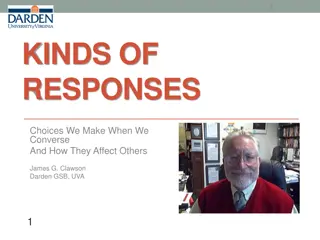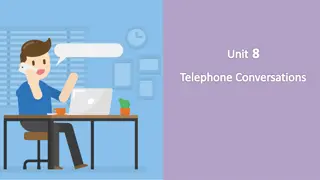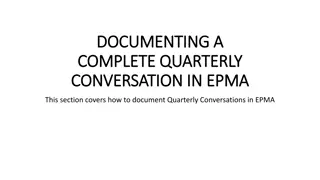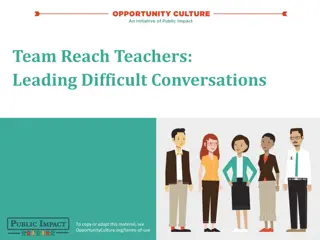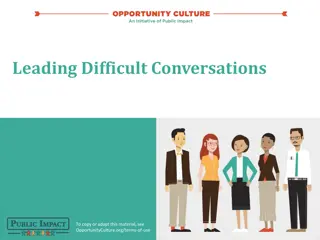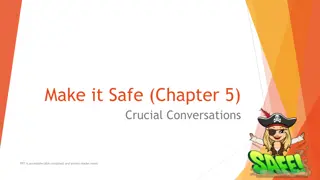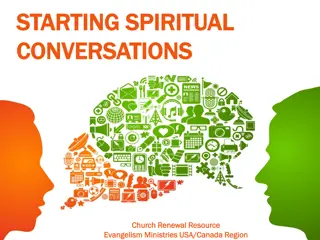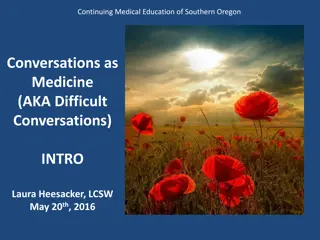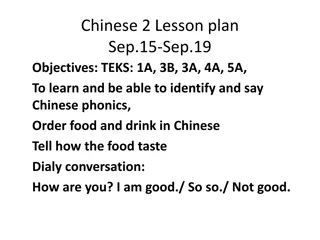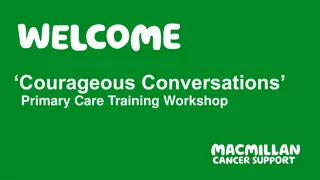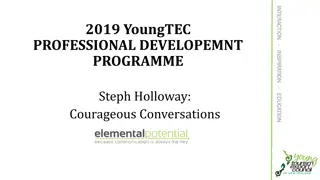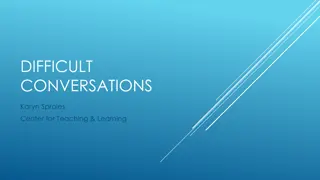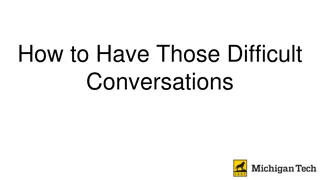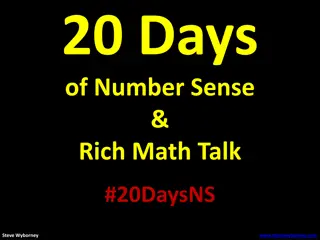Mastering Crucial Conversations for Effective Communication
Explore the art of crucial conversations, where the biggest communication problem lies in the illusion of understanding. Learn tools to navigate high-stakes discussions, understand the importance of holding such conversations, and discover the impact of shared meaning on effective communication. Gain insights into handling difficult situations like giving feedback, addressing offensive behavior, and managing relationships with honesty and respect.
Download Presentation

Please find below an Image/Link to download the presentation.
The content on the website is provided AS IS for your information and personal use only. It may not be sold, licensed, or shared on other websites without obtaining consent from the author. Download presentation by click this link. If you encounter any issues during the download, it is possible that the publisher has removed the file from their server.
E N D
Presentation Transcript
The single biggest problem in communication is the illusion that it has taken place George Bernard Shaw
CRUCIAL CONVERSATIONS TOOL S FOR TA L K IN G W H E N STA K E S A RE H IG H
WHAT IS A CRUCIAL CONVERSATION?
Examples: Ending a relationship Talking to a coworker who behaves offensively or makes suggestive comments Asking a friend to repay a loan Giving the boss feedback about her behavior Approaching a boss who is breaking his own safety or quality policies Critiquing a colleague s work Asking a roommate to move out Giving an unfavorable performance review Asking in-laws to quit interfering
Research; 20 year, 100 people Why do we need to hold these conversations? Key to being effective leaders, teammates, parents Capacity to skillfully address emotionally and politically risky issues
To Tell the Truth How do we typically handle crucial conversations? Fool s choice We are conditioned to being nice and to think that we can t be honest and respectful at the same time Consider between two bad alternatives Speak up and hurt the relationship or feelings Keep silent and never express the issue where it needs to be expressed
Our lives begin to end the day we become silent about things that matter Martin Luther King Jr.
What is a pool of shared meaning? Dialogue the free flow of meaning between two or more people Each of us enters a conversation with our own opinions, feelings, theories and experiences about a topic at hand. This unique combination of thoughts and feelings makes up our personal pool of meaning. This pool not only informs us but also propels our every action. When two or more of us enter crucial conversations, by definition, we don t share the same pool. Our opinions differ. I believe one thing; you another. I have one history; you another. (Crucial Conversations, pg. 24)
Not only does a shared pool help individuals make better choices, but since the meaning is shared, people willingly act on whatever decisions they make with both unity and conviction. (pg. 25) As individuals are exposed to more accurate and relevant information, they make better choices (pg. 24) The pool of shared meaning is a birthplace of synergy (pg. 25) How does the pool of meaning both motivate and enable people to make better choices?
Speak when youre angry and you ll make the best speech you will ever regret Ambrose Bierce
START WITH HEART How to stay focused on what you really want
Story Crucial Questions Awkward Performance Review Q. Why is it important to stay focused on what we want? What am I acting like I really want? Q. What motive might affect Melanie s ability to stay in dialogue if she s not careful? What do I really want? For me? For others? For the relationship? How would I behave if I really did want this? Focuson what you really want
Consider between two bad alternatives Crucial Questions Speak up and hurt the relationship or feelings What do I not want? OR How do I go about getting what I really want and avoiding what I don t want? Keep silent and never express the issue where it needs to be expressed Refuse the fool s choice
LEARN TO LOOK How to notice when safety is at risk
Emotional Scared Hurt Angry Beginning to react or to suppress these feelings Behavioral Raising their voice Pointing their finger Becoming very quiet Q. What cues can you use to recognize that your brain is beginning to disengage and you re at risk for moving away from healthy Q. How can you tell when a conversation turns from routine to crucial? dialogue Look for when the conversation becomes crucial
Silence or Violence are signs that people are feeling unsafe Silence Masking Sarcasm Sugarcoating Couching Avoiding Withdrawing Look for safety problems Violence Controlling Labelling Attacking Crucial Questions Are others going to silence or violence?
What is your Style Under Stress? Crucial Questions Am I going to Silence or Violence? Look for your own Style under Stress
MAKE IT SAFE How to make it safe to talk about almost anything
Mutual Purpose The Entrance Condition Mutual Respect The Continuance Condition Crucial Questions Do others believe I care about their goals in this conversation? Mutual Purpose means that others perceive that you re working towards a common outcome in the conversation, that you care about their goals, interests and values. And vice versa. You believe they care about yours. Consequently, Mutual Purpose is the entry condition of dialogue. Find a shared goal, and you have both a good reason and a healthy climate for talking. (pg. 77) Mutual Respect is the continuance condition of dialogue. As people perceive that others don t respect them, the conversation immediately becomes unsafe and dialogue comes to a screeching halt. (pg. 79) Do they trust my motives? Do others believe I respect them? Two Conditions of Safety
Contrast to fix misunderstanding Apologize when appropriate Q. What role does an apology play in restoring safety? Q. What is Contrasting? When people misunderstand your purpose or respect, how can Contrasting help? When you have made a mistake that has hurt others, start with an apology. An apology is a statement that sincerely expresses your sorrow for your role in causing or at least not preventing pain or difficulty to others. (pg. 84) Don t/do statement Contrasting is not apologizing, it is to provide context and proportion What can you do to rebuild safety?
Contrasting is a dont/do statement that: Example: I don t want you to think I m saying that I can t count on you. I find you to be quite reliable. I do, however, have concerns over what happened with yesterday s deadline. Addresses others conclusions that you don t respect them or that you have a malicious purpose (the don t part). Confirms your respect or clarifies your real purpose (the do part).
What to do in situations where we have different purposes? Create a Mutual Purpose CRIB 1 2 3 4 Commit to Seek Mutual Purpose Recognize the Purpose behind the Strategy Invent a Mutual Purpose Brainstorm New Strategies
MUTUAL RESPECT HOW WOULD YOU RESTORE SAFETY? ONE POSSIBLE SOLUTION
MASTER MY STORIES How to stay in dialogue when you re angry, scared or hurt
THE PATH TO ACTION Tell a Story See and Hear Feel Act
01 02 03 04 Retrace my Path to Action Skills for Mastering Our Stories
Retrace my Path to Action SEE/HEAR TELL FEEL ACT Analyze your stories Crucial Question What story is creating these emotions? Get in touch with your feelings Crucial Question What emotions are encouraging me to act this way? Notice your behavior Crucial Question Am I in some form of silence or violence? Get back to the facts Crucial Question What evidence do I have to support this story?
01 02 03 04 Retrace my Path to Action Separate Fact from Story Watch for Three Clever Stories Skills for Mastering Our Stories
Three Clever Stories Victim Stories Its Not My Fault Villain Stories Its All Your Fault Helpless Stories There s Nothing Else I Can Do
01 02 03 04 Retrace my Path to Action Separate Fact from Story Watch for Three Clever Stories Tell the Rest of the Story Skills for Mastering Our Stories
Tell the Rest of the Story Turn victims into actors Villains into humans Helpless into able Crucial Question Am I pretending to not know my role in the problem? Crucial Question Why would a reasonable, rational, and decent person do what this person is doing? Crucial Question What do I really want? What would I do right now if I really did want these results?
S.T.A.T.E. MY PATH How to speak persuasively, not abrasively
Share your facts. Start with the least controversial, most persuasive elements from your Path to Action. S T Tell your story. Explain what you are beginning to conclude. A Ask for others paths. Encourage others to share both their facts and their stories. T Talk tentatively. State your story as a story Don t disguise it as a fact. E Encourage testing. Make it safe for others to express differing or even opposing views.
EXPLORE OTHERS PATH How to stay listen when others blow up or clam up
A Ask to get things rolling Start by simply expressing interests in the other person s views M Mirror to confirm feelings Increase safety by respectfully acknowledging the emotions appear to be feeling Paraphrase to acknowledge the story As others begin to share part of their story, restate what you ve heard to show not just what you understand, but also that it s safe for them to share what they re thinking P P Prime when you re getting nowhere If others continue to hold back, prime. Take your best guess what they may be thinking and feeling.
A Agree when you agree. Start with an area of agreement. If you agree with what has been said but the information is incomplete, build. Point out areas of agreement, and then add elements that were left out of the discussion. B When you don t agree, rather than suggesting he or she is wrong, suggest that you differ. Compare your two views. C
MOVE TO ACTION How to turn crucial conversations into actions and results
Decisions are made without involving others Command Decide how you ll decide Input is gathered from the group and then a subset decides Consult An agreed-upon percentage swings the decision Vote Everyone comes to an agreement and then supports the final decision Consensus
Document decisions and follow-up Who will do what by when? How and when will we follow up?




